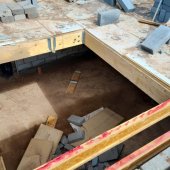Multi-award-winning St Sidwell’s Point

St Sidwell’s Point in Exeter is the first leisure and swimming pool complex in the UK to be built to the Passivhaus international building standard. We speak to Joe O’Connell, Senior Project Manager at Kier Group, which oversaw the delivery of the multi-award winning design using sustainable construction technology.
Just over a year ago, Kier handed over St Sidwell’s Point to its client Exeter City Council and the UK’s first Passivhaus leisure centre and swimming pool opened its doors to the public on 29 April 2022.
Located in Exeter city centre, the £42m flagship project is integral to the council’s goal of creating a Net Zero Carbon City and arguably is its most ambitious Passivhaus building to date.
As Joe O’Connell, Senior Project Manager at Kier explains, Exeter City Council has been building social housing to the Passivhaus international building standard for more than ten years.
However, the decision to contract Kier to deliver the project to this exacting building
standard was a bold one given St Sidwell’s Point’s geometrically complex design and its intended end use.
‘Constructing swimming pools are known to be a challenge; they are buildings with high relative humidity and it’s about keeping that humidity maintained and preventing it leaking,’ he says.
Through its collaborative work with Exeter University and its climate change predicting platform Prometheus, Exeter City Council’s entire ethos centres around saving energy, reducing its carbon footprint and constructing buildings that can adapt to climate change.
Delivering St Sidwell’s Point to the Passivhaus standard ticked all of these boxes and also meant it would be built to be climate resilient for 2080.
Passivhaus standard
The Passivhaus Trust, an independent industry body that promotes the adoption of Passivhaus in the UK, explains how buildings account for 35% of total energy consumption. However, it argues that this can be reduced by taking ‘a whole-building approach with clear, measured targets, focused on high-quality construction, certified through an exacting quality assurance process’ (https://www.passivhaustrust.org.uk/what_is_passivhaus.php).
To achieve the Passivhaus Standard in the UK, construction firms are required to meet certain requirements. These include, for example, achieving very high levels of insulation; airtight building fabric; ‘thermal bridge free’ construction; and mechanical ventilation systems with highly efficient heat recovery.
Assisted by a number of designers and supply chain partners Kier delivered the leisure complex against a challenging brief and during a time when the COVID-19 pandemic significantly disrupted work onsite.
As O’Connell explains, St Sidwell’s Point was the most collaborative project that he has ever worked on. Delivered over two stages, Kier was first contracted to head up an eight-month pre-construction stage that involved de-risking the project by identifying all of the unusual challenges and gaps in the partners’ knowledge.
The team had to mitigate the impact of the pandemic but despite this, the multi-award winner, including the Royal Institution of Chartered Surveyors 2022 award for environmental impact (https://www.business-live.co.uk/commercial-property/rics-reveals-winners-grand-final-25325154) met all of the Passivhaus standard’s requirements.
To start with, through the incorporation of healthy-building biology principles, St Sidwell’s Point has made annual energy savings of 70% when compared to traditional leisure centres (https://www.kier.co.uk/media/news-releases/kier-completes-uk-s-first-passivhaus-leisure-centre-st-sidwell-s-point-in-exeter/).
As O’Connell explains, Passivhaus focuses heavily on the energy performance of a building and how the environmental impact is minimised over its lifetime through the energy used.
‘Exeter City Council knew they were going to end up with a building that was going to perform fantastically well and be built to an exemplary standard,’ he explains.
‘To balance that, they looked around at other standards that they could bolt on to the requirement to raise the benchmark of the building’s performance. Building biology underpins that ethos of what they were trying to achieve around healthy buildings and is about avoiding “unhealthy” products containing volatile organic compounds, for example.’
Air tightness accreditation
Importantly, the energy efficient project surpassed an industry leading air tightness test that was critical if it was to attain accreditation to the Passivhaus standard.
To do this, Passivhaus required Kier and its project partners to achieve an air permeability measurement of 0.4 m3/hr/m2 at 50 Pascals. They did even better. When a traditional building regulations compliant building is only required to achieve 8.0 m3/hr/m2 at 50 Pascals, they achieved 0.3 m3/hr/m2 at 50 Pascals.
‘It’s incredibly difficult to achieve that level of air permeability on even a regular, square building so to achieve that on a building with that level of complex façade and geometry was really a big achievement. In fact, it was the biggest challenge on the project,’ O’Connell says.
‘It isn’t just about someone turning up and doing the air test. The actual air tightness strategy is developed really early on in the design stage.’
The painstaking planning undertaken during the pre-construction stage was critical to the project’s overall success.
Once O’Connell, together with Exeter City Council and the two designers, Space & Place Architects and Gale & Snowden Architects, had de-risked the project, Kier Group’s Senior Project Manager produced a risk mitigation strategy to capture all of these requirements, one of which was the need to draw on the best UK air strategists for support.
Working with the UK’s most experienced air testing consultants ALDAS, O’Connell and his team developed an effective strategy that was instrumental in achieving the Passivhaus accreditation for air permeability.
Pre-construction tests pay off
Even so, the process required some forward and innovative thinking. Due to St Sidwell Point’s ‘open’ atrium design, it was not going to be possible to test the building’s air permeability until very late on in the build, explains O’Connell. To get around this, Kier built a series of actual size building mock-ups of the external facades and tested them offsite.
‘What we found was that almost without exception, nothing performed in the way that we were expecting it to perform,’ he says.
‘Part of that is that components are often tested in almost laboratory conditions and tend to perform better than they might on a site.’
To resolve any potential issues arising from this, Kier made changes to the external design based on the data that was collected from the testing regime.
‘If we hadn’t done that, we would have failed,’ continues O’Connell. ‘It was that important. However, we did recognise this risk which is why we went to the effort of building the mock ups and testing them, so by the time we got the point of starting to build the façade of the leisure centre, we had a robust design based on the testing performance data.’
O’Connell also approached the UK’s top Passivhaus certifying consultants WARM to
undertake a peer review of the air tightness design once it had been finalised and this was critical in the design achieving Passivhaus accreditation.
Supply chain challenges
During the pre-construction phase, Kier soon realised that all of the supply chain components that were planned to go into the building would have to be challenged.
‘We made the supply chain come in and demonstrate to us practically how their products fared under site conditions and on the back of that, we made a lot of changes collaboratively with the designers,’ he says, adding that Kier had run a short competition to source the best suppliers.
O’Connell continues: ‘By doing this, we were able to demonstrate to our client that they were getting the best value, but also that gave us the ability to tap into that expert knowledge and our supply chain specialists were happy to provide that engineering support. It really was a textbook collaborative process. Our client played a big part in that as well.’
Ceramic micro-filtration in pools
St Sidwell’s Point benefits from other innovations. The four-storey building contains four swimming pools – a 25m eight-lane pool for competitions; a 20m community pool; a children’s pool – together with a health and fitness centre hydro spa.
In what was only the second installation of the technology in a UK public swimming pool, each of the pools uses ceramic micro-filtration (together with UV treatment) to enhance the water’s purity and quality. In other words, virtually no chlorine is needed.
‘Rather than using the traditional sand filtration systems, which most UK swimming pools use, they use micro-filtration,’ explains O’Connell.
‘Water is pumped through ceramic membranes and these sift the water. Sand will sift water down to circa 10 microbes whereas the micro-filtration sifts that water quality down to 3 microbes.’
According to the Architectural Technologist Awards 2022, the project has delivered a 50% reduction in water use, outstanding internal water quality, excellent daylighting levels, healthy internal environments and reduced maintenance costs (https://architecturaltechnology.com/awards/at-awards-2022-winners-gallery/at-awards-winners-excellence-large-to-mega/winner-st-sidwells-point.html).
Smart building materials
St Sidwell Point’s environmental credentials also extend to the building’s fabric. As
O’Connell notes, Exeter City Council chose the building materials based on a requirement for longevity and sustainability. This includes the use of a wooden roof structure that incorporates a 33m-long timber glulam beam (https://news.exeter.gov.uk/striking-timber-roof-beams-craned-into-position-at-st-sidwell-s-point/).
The beam is made of different layers of dimensioned timber that are bonded together with durable, moisture-resistant adhesives, note Exeter City Council.
As the council’s website explains: ‘By laminating a number of smaller pieces of timber, a single large, strong, structural member is manufactured from smaller pieces. These structural members are used as vertical columns or horizontal beams, as well as curved, arched shapes.’
Future-proofing workforce
Without a Passivhaus experienced Tier 1 supply chain in the southwest to deliver to the client’s Passivhaus requirements on St Sidwell’s Point, O’Connell recognised from the outset that Kier would need to upskill its own build team first and then its supply chain.
To do this, Kier approached leading Passivhaus certification group WARM to help put together some bespoke training modules so that the entire workforce could be trained to the Passivhaus standard.
As an assurance that the newly trained workforce couldn’t be diluted, for example, by bringing construction workers from nearby developments onto the project build without first having had the Passivhaus training, Kier and WARM also developed a unique entry requirement.
‘We came up with this Passivhaus passport so everybody that worked on our site and had been through the training module had this passport,’ he says. ‘You couldn’t come on to our site and work on it unless you had that evidence of your training.’
Kier’s Senior Project Manager was amazed by the level of buy-in into the passport scheme from the supply chain and estimates that around 70 trades and more than 2,000 operatives worked on the project and developed their skills in the process.
‘One of the legacies of St Sidwell’s is that everybody that worked on that site through that learning process is taking that skill-set and experience to the other projects they are working on,’ says O’Connell who received two Chartered Institute of Building awards on the back of the project.
‘That attention to detail and that recognition of exemplary work that they would have taken to their new jobs; that is something that I am really proud of.’








